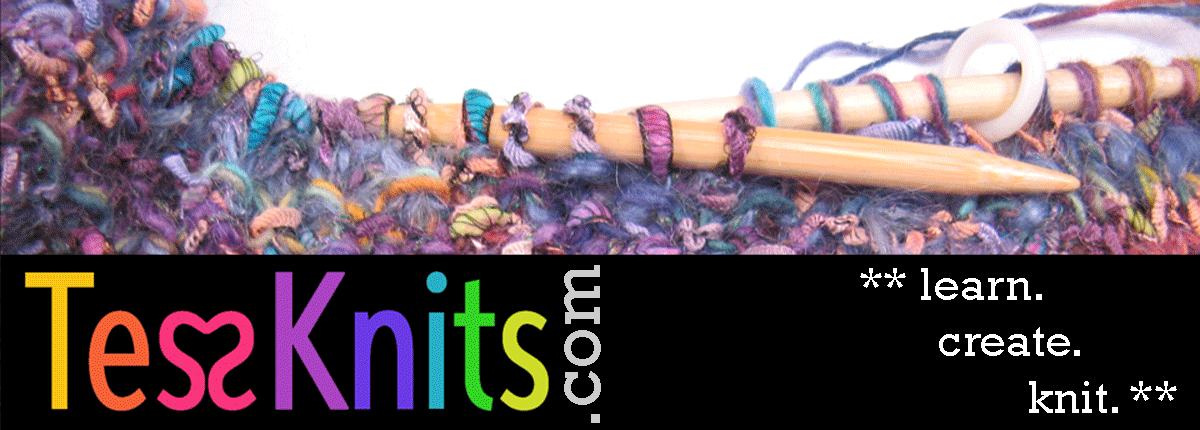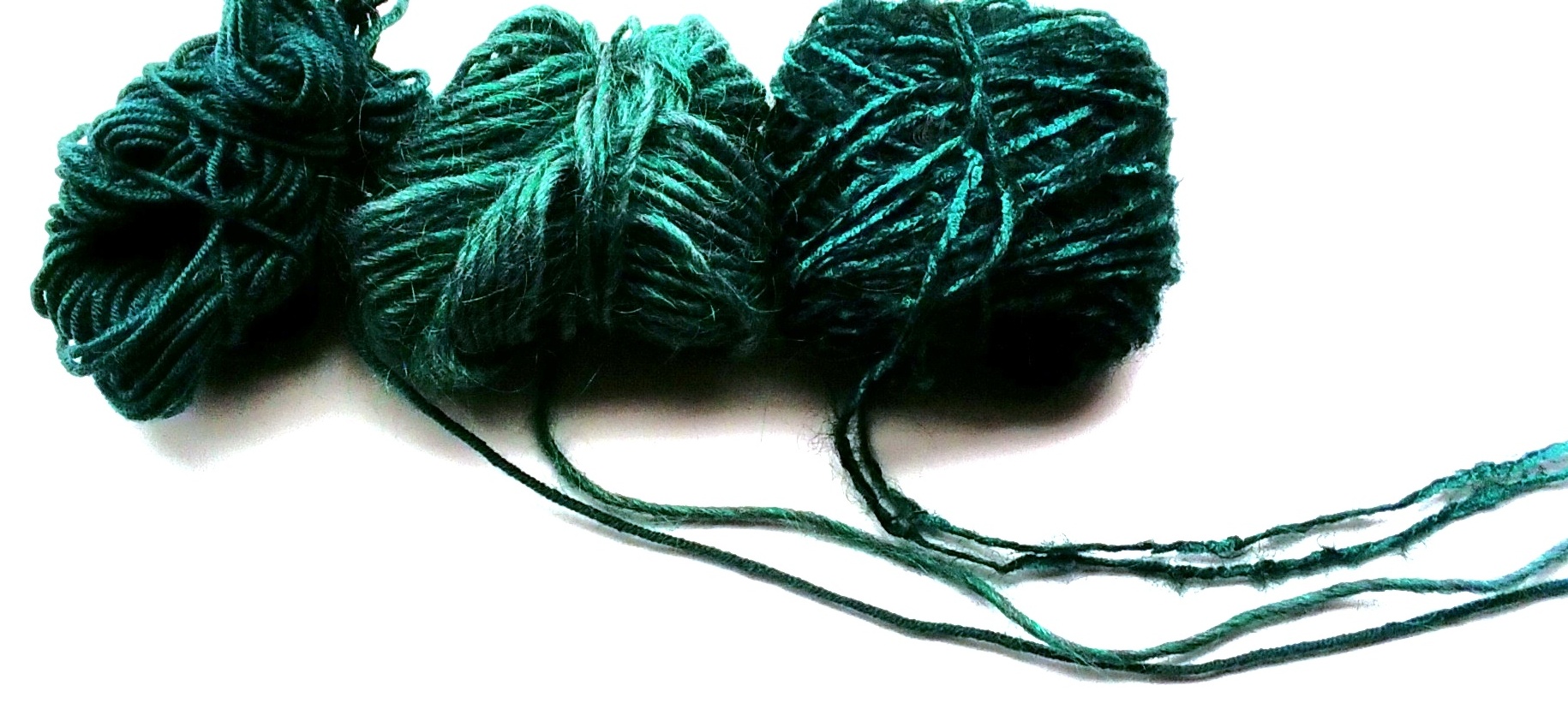Lately I’ve been seeing a lot of capelet patterns showing up on the radar, and I have an idea it might be “the” thing to knit this fall. And I can see why. A month or so ago I came across this Berroco design, “Rini”, and really loved it. Immediately, the dreamy dark blue-green color and the enormous stitches both appealed to me.
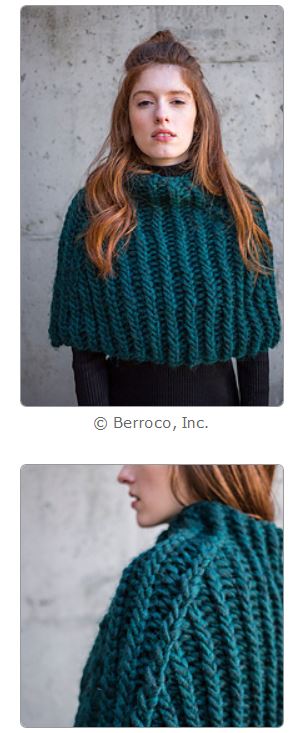
Ravelry screenshot
Also, this looks like a knitted accessory that I might actually get some use out of. I have to confess that I honestly just don’t wear too many knitted accessories. Sweaters, yes, definitely — but scarves/cowls, wraps/shawls, hats, mitts, even socks are not things I wear on a daily basis. Oh, of course I have a few hats to wear when the weather is cold, or cowls and scarves for when I feel like a little extra something — but in the main, I just don’t wear much knitting, except for my sweaters. I feel like this is going to be a useful thing to toss on when I feel a little chilly this winter — maybe even over a sweater!
Finally, the knitting is pretty simple. It’s knitted in the round, starting out straight, then a series of decreases, and finally more straight knitting. Easy-peasy.
Bonus: this would make an excellent gift, I think, if you wanted to get a jump on your holiday knitting. You know, like we all swore we would last year, around December 20th or so.
So, all-in-all, this looked like a promising project. As I looked into the details, though, of course I found a few things I wanted to change… and I’m really pleased with the final product, so just read along for the ride, or knit your own version with me as I show you how!
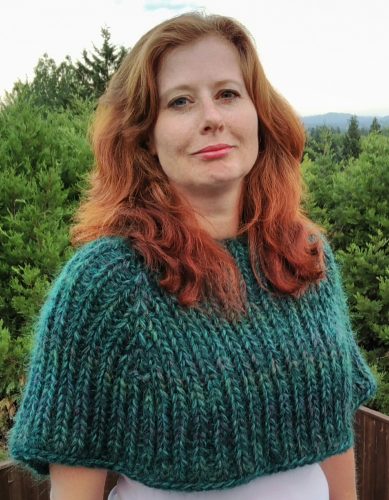
My finished capelet
First design change: knit this top-down.
The first problem here is the sizing – or lack thereof. This is designed in one size: 18” around at the neck, 40” around at the lower edge, and 18” total length.
Looking at the five projects on Ravelry at the time of writing, four knitters had expressed concern about it being too small.
This is knitted bottom-up, so some of those knitters added a few rounds before starting the decreases, in an attempt to get a better length. But that’s basically guesswork.
I found another large-gauge capelet, the Mountain Capelet, in my favorites, and checked the sizing. It’s a little bigger, but still only written in one size:
circumference around bottom: 45″
circumference around cowl: 24″
height from bottom edge to bottom of cowl: 12″
These dimensions are a little wider and shorter overall, but they are in the same ballpark, so we now maybe have a lower and upper limit of what we are aiming for. But this still isn’t going to fit everyone the same way.
So how to determine if, and how, this is going to fit — before going to the trouble of knitting it?
The answer is, you don’t. You do it during.
A truism about sizing knitting: knitting from large dimension to small dimension is tough.
This is because you end up hoping that you manage to get it small enough quickly enough to get the right length — in this case, that means guesswork about when to start decreasing.
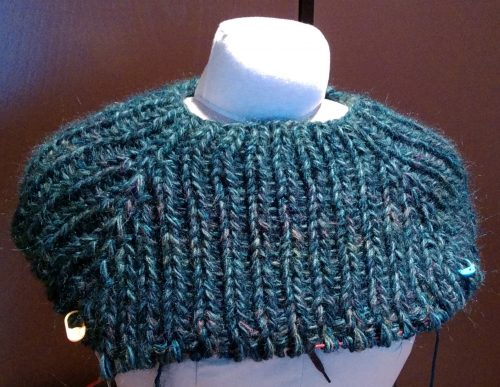
Top-down lets you test the fit
But it’s much easier to get the right fit if you knit from small dimension to large, because then you can do one thing at a time: first get the neckline right, then increase until it is as large as you want it to be, THEN worry about the length. And since you can try it on at that point, it’s simple to just stop when it’s long enough. (Or when you use up all your yarn, as I did.)
So, in order to be able to fine-tune the sizing, I would not knit this bottom up, but rather top down.
For myself, I mostly kept to the original sizing. After hanging a tape measure around my own neck, I decided to pull the neckline in a bit from 18” to 16”, but I kept the 40” lower edge, and I planned to adjust the total length however I wanted once I got there, depending on my yarn amounts. But it’s safe to say it would be between 12″ (Mountain Capelet) and 18″ (Rini) long.
Second design change: fabric structure and yarn
The original used a super bulky yarn, at 7 sts/inch, in twisted rib, on size 19 needles.
First of all, I love ribbing, and I do love me some big textural stitches. But I personally don’t like the look of twisted rib: it’s the way the stitches tend to pull away from each other and make a ladder-like appearance. So I decided to stick with regular 1×1 rib, not twisted, to maintain the overall effect of the large ribbed stitches.
Next, there is that super bulky yarn. I understand that yarn companies write patterns to sell yarns. However — I also have way too much yarn at home to go buying some super bulky for this project. So what I chose to do instead is combine several strands of yarn into one bulkier equivalent.
According to 3 of the projects on Ravelry, the original uses 1.5 skeins of the super-bulky yarn, which is about 170 yards’ worth. I was aware I might have trouble finding enough stash yarns that went together nicely to equal a true super-bulky, so I knew I might need to go down a needle size or two from the original.
Another knitting law: if your gauge is smaller, you will use less weight, but more yardage.
Therefore I knew there was a good chance I’d need more than 170 yards, if I didn’t quite get to super-bulky.
I loved the original color, so I did some virtual stash-diving on Ravelry, looking at blue-green yarns of which I had at least 200 yards.
I was being pretty strict about color, keeping everything to solid or nearly solid blue-green, and I soon had a core selection of 3 yarns that I really liked. Two were in the 200-yard range, and I had 400+ yards of the third one, so I planned on doubling that one.
This gave me a total of four strands of approximately worsted weight yarns (meaning I actually had aran weight and DK weight in there, but since one is heavier and one is lighter, they averaged out more-or-less to worsted weight). And four strands would safely get me into bulky territory, at least.
Full disclosure: I ran out of yarn before I got to the finished length I wanted. Mine is a tad bit cropped, with a final length of about 13.5″ — which is still a little longer than the Mountain Capelet, and I should have noticed that that design took almost 200 yards. Some of that yardage is in the large cowl, which is 8″ high x 24″ around, and that amount of yarn would have made roughly 4″ more capelet at 45″ around — which would have brought the Mountain Capelet length to about 16″ long — and if 16″ of capelet takes 200 yards at that larger gauge, I should have known I’d need more than 200 yards at my smaller gauge, to get to about the same length.
In fact, I did the bind-off round with one of the yarns left out, because I wanted to get as much capelet as I could and I knew the missing yarn wouldn’t be obvious in the BO round. This is another great thing about working top-down: if you’re going to be playing yarn chicken, I know I’d rather run out at the bottom than the top, and you might as well stack the deck in your favor.
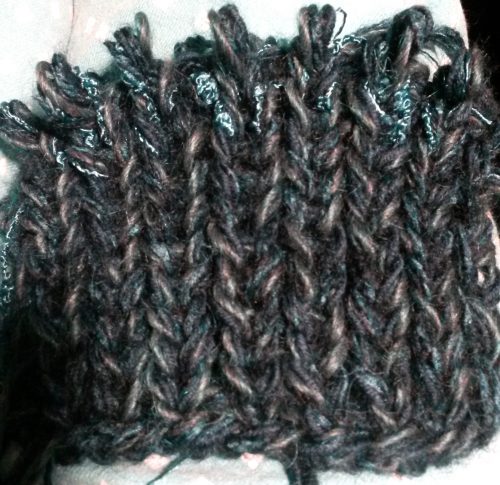
Rini swatch in progress
Then, of course, I did some swatching. I find it hard to accurately visualize how a combination of yarns will look when knitted up, so I need to test drive it. Unfortunately, it was almost impossible for me to get a picture that really shows how these yarns look when knitted, because they are so dark, I guess. Trust me, the color’s rich, like in the picture of the balls of yarn. Yum!
Also, I needed to check that the fabric was not too loose, after all these changes. As I had kind of expected, my yarn subs were not quite bulky enough, and the fabric was awfully loosey-goosey on size 19 needles — so right away I went down a size, to 17’s.
But the bigger problem was that the core 3-yarn combo was kind of “meh” — it just didn’t “pop”.
So I continued swatching, and tried adding in half-a-dozen other yarns, one at a time. Finally, I landed on this combo.
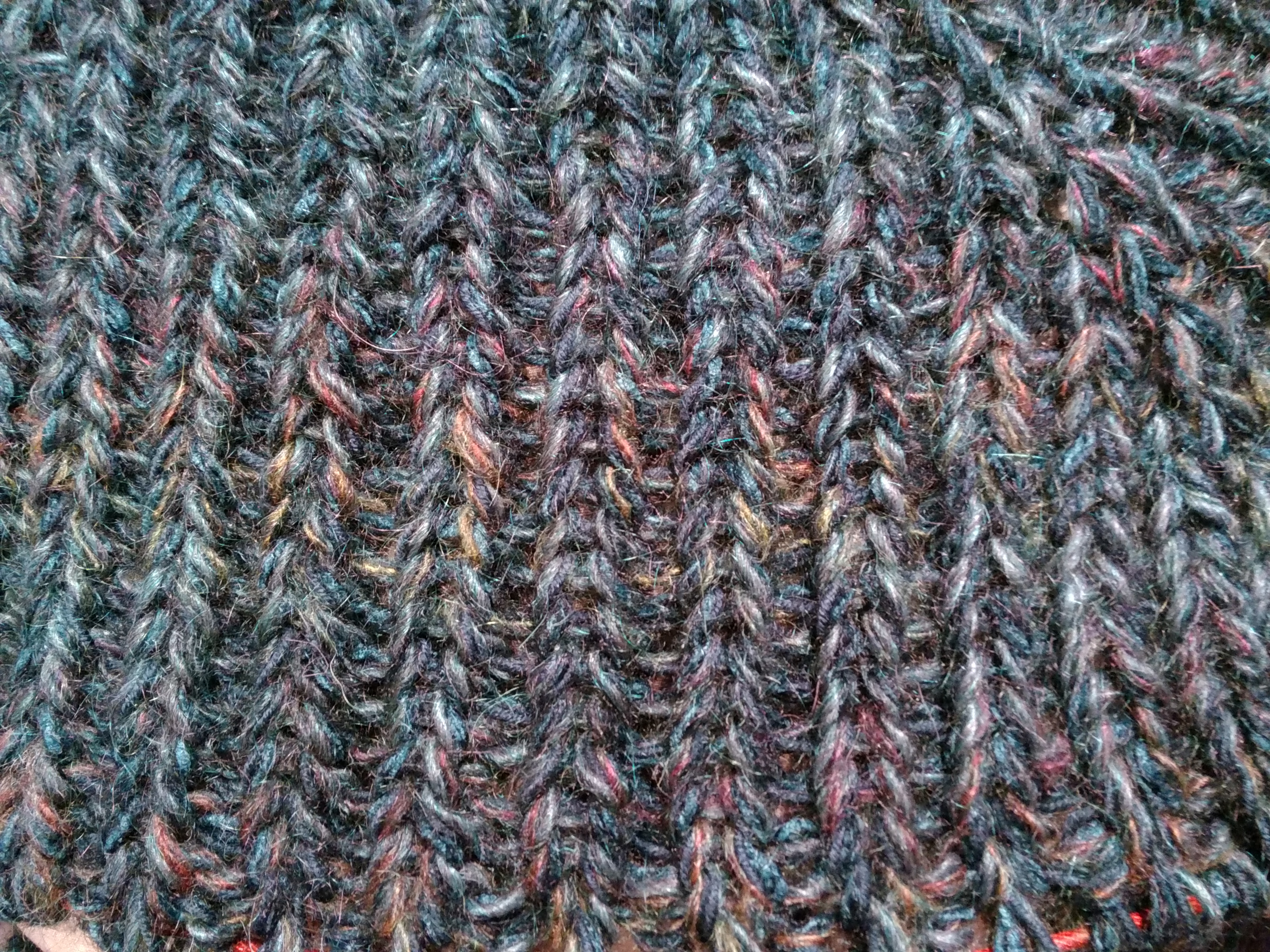
Rini final fabric
You just don’t know how annoyed I was that the answer to my “lack of pop” problem turned out to be a multicolor yarn. OK, it is just a very thin strand of it, but still. I had been trying so hard to stick to monochrome. But that’s how it goes. Knit and learn.
Anyway, what with the changes in pattern stitch, needle size, and my personalized yarn combo, I was pretty sure I wasn’t going to get the pattern gauge, and I was right. My gauge ended up being 12 sts to 4 inches, or 3 sts/in – nearly half the gauge that was called for in the pattern, of 1.75 sts/in.
One more note about yarn choices: Tahki Stacy Charles has published their own version of this accessory, in a standard gauge and 2 x 2 ribbing, which gives quite a different look to the raglan increase lines. The El Dorado capelet has a matching Empire cowl. The ingenious part here is that the capelet and cowl are knit entirely separately. Consider using this idea if you have much more of one yarn than the others, or if some of your yarns are too scratchy to wear right around the neck: you could knit the caplet with all yarns, and then knit a separate cowl to go over it in a softer yarn, or a yarn that you have more of.
Third design change: the shaping formula
Both of my reference capelets use a modified raglan shaping: that is, instead of doing 8 decreases every other round, they use 4 decreases every round. The resulting shape is basically the same; it’s just the knitting that’s different.
I chose to do regular raglan shaping, mostly because I’m very familiar with it and can do it in my sleep.
With hindsight, and at this larger-than-average gauge, I might instead have chosen to do the same as these two designers did: because with standard raglan shaping, the multiple of 8 sts for each shaping round means you have less control over how big the neckline and bottom edge are going to be. Your options are limited to multiples of 8 sts (instead of 4 sts), and at my gauge, 8 sts is more than 2.5 inches. At the original pattern gauges of 6-7 sts over 4”, it’s an even bigger step: an 8-st multiple is obviously more than 4”. So there’s that — but in a loose-fitting capelet, it’s really not that big of a deal.
OK, so now I have chosen my dimensions; my yarns; my pattern stitch, needle size and gauge; and my methodology. Let’s do some math.
Design Considerations and Calculations
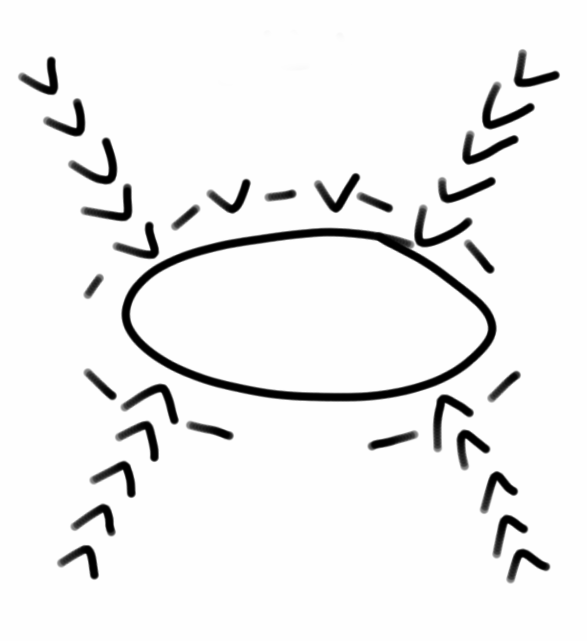
Raglan seams in 1×1 ribbing
Stitch Pattern:
I planned to have a single knit stitch running down the four raglan lines, and to place pairs of increases on either side of them. For the 1 x 1 ribbing pattern stitch to come out right, this means I need to set off one stitch for each line, and have an odd number of sts separating them, so that each section is symmetrical — that is, they each start and end with a purl. See in the drawing that there is one purl st to either side of the knit seam sts?
To start and end a section with purls, you need to have a “multiple of 2 + 1”, or an odd number of stitches in each section. A lot of other math that I won’t bore you with boils down to this: you need to have a multiple of 4 sts to start with.
Neckline:
At my gauge of 3 sts/in, to get my 16″ neck circumference, I needed 48 sts.
Calc A. 16” x 3 sts/in = 48 sts
Multiple of 4 sts, check, so I lucked out there! (If yours isn’t, just round up or down a couple of sts to get there.)
Dividing the neckline:
If you then subtract out the 4 seam sts, there are 44 sts left to split up between the two front/back sections and the two shoulder sections:
Calc B. 48 sts – 4 seam sts = 44 sts
We need an odd number of sts in each section. You could go with 11 sts in each section and make this square, which would give you a poncho shape. I want more of a rectangle, and the rule of thumb for a standard raglan sweater yoke is that the front/back sections are about twice as big as the shoulders. So I divided answer B by 6 to get the approximate number of stitches for one shoulder:
Calc C. 44 / 6 = 7.33
Round this to the nearest odd number. I rounded this to 7 sts for each shoulder section.
If we have 44 sts to divide up, and we use 7 each for the shoulders, we then have 30 sts left to divide into the front and back sections:
Calc D. 44 – 7 – 7 = 30
Calc E. 30 / 2 = 15
The multiple of 4 that we started out with will force the odd number we want for the front and back sections. And that 15 sts for the front/back sections is about twice as much as the 7 sts for the shoulder sections, as expected. So my 48 sts will be divided up as follows:
15 front section
1 seam st
7 shoulder section
1 seam st
15 back section
1 seam st
7 shoulder section
1 seam st
—————————-
total = 48
Lower edge and increase rounds:
Now, with this much information, you could just cast on and start knitting, increase until it’s big enough, and then knit straight until it’s long enough. If this slightly experimental approach appeals to you, go for it, and have fun!
But for the rest of us, we need to look at where we want to end up. I am aiming for 40” at the lower edge:
Calc F. 40” x 3 sts/in = 120 sts
Standard raglan increases are done every other round, with 2 stitches being increased at each “seam”. With 4 seams, you will gain 8 sts for every inc round. Since we started with a multiple of 4, and since we add 8 sts every time, the number of sts at the lower edge has to also be a multiple of 4.
Again I lucked out, and my 120 sts is OK. But if yours isn’t a multiple of 4, hang on, because it actually has to be the RIGHT multiple of 4 and we have to consider a couple of additional things here.
It turns out that, if you start with knit increases, and you have an ODD number of increase rounds, you will end up not with a nice 1×1 rib all the way around at the end – instead you will have 3 knits in a row, at each of the four seams. Ask me how I know.
Now, you could consider that a striking design feature, or you could think that it sticks out like a sore thumb. I am in the latter camp.
So in order for the 1×1 rib pattern to work out nicely at the end — which is, visually, where it matters — there is certainly more than one solution to that problem. You could set up each section to start and end with knits instead of purls; or you could change the neckline number and recalculate, and so on. The solution presented here is to make sure you have an even number of increase rounds.
So, how many increase rounds will there be? If I start with 48 sts, and I want to end up with 120 sts, I will need to increase a total of 72 sts:
Calc G. 120 sts – 48 sts = 72 sts
And there are 8 sts gained for each increase round:
Calc H. 72 sts to increase / 8 sts inc’d per round = 9 increase rounds
Obviously, you can’t do a partial increase round, so this has to be a whole number. And once more I kind of lucked out on the math, and I came up with exactly 9 increase rounds. But 9 is not an even number.
So take whatever you got for answer H, and round it to the nearest EVEN whole number, thusly:
• If you got 9.75, round it to 10.
• If you got 8.25, round it to 8.
• But if you got 8.75, don’t round it to 9 – go back down to 8.
• If you got 9 exactly, as I did, I would suggest that you round up to 10, rather than down, just to give yourself more elbow room in the finished product.
(If you’re not 100% sure about this decision, remember that when you finish the 8th increase round, you can always slip half the sts to a string or spare needle, and try it on to decide whether you need to do more increase rounds!)
Finally, as a double check, take your rounded number, multiply it by 8, add that to your start number, and see how close you are to your bottom edge number:
Calc J. 10 inc rounds x 8 sts inc’d per round = 80 sts added
48 + 80 = 128 sts at bottom edge
128 sts / 3 sts per inch = 42.67” new lower edge circumference
This new circumference is well within the 40 – 45” range that I found when I did my initial research (on those two “one size fits all” patterns) so I’m comfortable with that change.
Knitting
You’ll need 8 st markers, one of them unique (for the beginning of the round), and a circular needle.
CO your neckline sts (A sts) and join in the round. Place beg of round marker.
Work even in K1, P1 rib for a few rounds: about 1” worth.
Increase Setup round:
This is setting up to do standard raglan increases. You have 4 seam sts (K sts) that are set off by the pairs of st markers. On increase rounds, you will increase one stitch on either side of each seam stitch, for a total of 8 new sts. All increases will occur outside the marker pairs; thus, you should never have more than a single knit st between a pair of markers.
Slip beg of round marker, work 1 K st, place marker.
Work front section (E sts), place marker, work 1 K st, place marker.
Work shoulder section (C sts), place marker, work 1 K st, place marker.
Work back section (E sts), place marker, work 1 K st, place marker.
Work shoulder section (C sts).
Round 1 – Knit inc round:
After this round you will have sets of three knit sts in a row at each seam st.
Slip beg of round marker, K1, sl marker, M1, work in established pattern to next marker.
** Before next marker, M1; sl marker, K1, sl marker; M1; work in established pattern to next marker. **
Repeat between ** twice more.
At the end of the round, M1 (before the beg of the round marker).
8 sts increased.
Round 2 – Plain round:
Work in established patt, being careful to work the new sts as knits.
Round 3 – Purl inc round:
After this round you will have re-established the K1, P1 pattern all around.
Slip beg of round marker, K1, sl marker, M1 purl, work in established pattern to next marker.
** Before next marker, M1 purl; sl marker, K1, sl marker; M1 purl; work in established pattern to next marker. **
Repeat between ** twice more.
At the end of the round, M1 purl (before the beg of the round marker).
8 sts increased.
Round 4 – Plain round:
Work in K1, P1 rib around.
Continue working rounds 1-4 of pattern until you have reached the number of sts for your lower edge (J sts).
Continue to work even in pattern until the piece is as long as you want it to be. Bind off.
Remember: You can try it on at any point by slipping about half the sts to a spare circular needle.
Happy Knitting!
